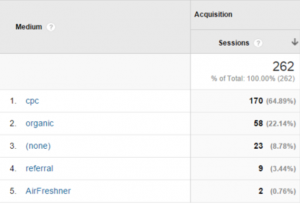The Dirty Little Secrets Behind Website Traffic Sources
As an analytics specialist, my job is to look at numbers all day long and I love every second of it! What I don’t like however, is imprecise data.
It is critical that we give our clients accurate numbers and campaign results because they use these reports and numbers to move their businesses forward and make key business decisions. More importantly, they spend their money based upon these numbers, which definitely adds a different level of pressure to the equation.
I’m Not Creepy… I Swear!
In our always-connected-to-the-interwebs world, you are always being tracked. Everything you do is closely monitored by the government, your internet service provider, and probably an analyst just like me! Let’s get something straight, I don’t care who you are or where you live (although I am sure you and your home are lovely). I thrive on making our clients’ websites the most efficient that they can be, which makes it easy for you to convert. But I digress, let’s get back to why you clicked this article in the first place—traffic sources!
Traffic Sources
If you’ve poked around in your Google Analytics (GA) account then you’ve likely seen the traffic sources section. It’s one of the first sections clients or analysts look at. Typical traffic sources include organic, direct, referral, paid, and social. In the example below, you can see an extra, somewhat unusual source – AirFreshner. What?!? Air Freshner was actually me – coming in directly by adding UTM parameters to the URL. The point is that GA isn’t perfect, it doesn’t really think for itself, it can attribute traffic to one source that really came via another source. This can make it more difficult to understand user behaviour.
How Does It All Work
Let’s start by understanding how GA records its data. Everything starts with a query string! The query string parameter is everything that comes after the “?” in the URL you type in. As a user, you never fill out these parameters manually (except perhaps to get in as an “AirFreshner”).These query strings are auto-filled if coming from an online ad, and this is how analysts know that you came into the website from a specific campaign, keyword, source and/or medium.
Google also automatically fills out this information on the back-end of GA for organic, direct, and referrals. This is where discrepancies tend to happen… 95% of the time organic traffic and referrals are correct. It’s that darn 5% and the “direct” bucket that can be frustrating.
No More Selfies!
Most websites now have multiple domains that the user can hit during their visit and in some cases, this creates “self-referrals”. You’ll know you have self-referrals if you see your OWN domain in the traffic sources report… Not very helpful, right? Here is a simple hack you can do if you need to filter out your own domain from your reports.
- Go to the Admin tab and find “Referral Exclusion List”, under “tracking info” in the property section.
- Add your domain to the list and voilà! Your data should be cleaner going forward.
Unfortunately, you can’t go back in time to change all of your visits, but getting good data moving forward is still a big win!
(In)Direct
Now let’s talk about the “Direct” bucket, the bane of my existence. This is one for the ages. Google already described this bucket as being “an alternative to other traffic sources”. They’ve since changed the wording of this statement, but it essentially means that Google attributes traffic to Direct because they don’t know where it actually came from.
Wrong UTM codes? Direct!
No tracking on this email campaign? Direct!
Search engine that blocks your query? Direct!
HTTPS referral? Can you guess this one? It’s Direct!
This may look like a complete mess until you get things figured out, but understanding what is happening to your data and how it is collected is 75% of the battle! Once you pinpoint the possible issues you might be facing with your traffic sources, do your best to fix them. By ensuring quality tracking, your data will provide you with a much better picture of what is actually happening on your website.
Lastly, smile when you find these issues! The fact that you have found them is the most important part 🙂
Leave a comment, tell us what your issues are and how you fixed them! We are very interested in your opinion and your stories.
